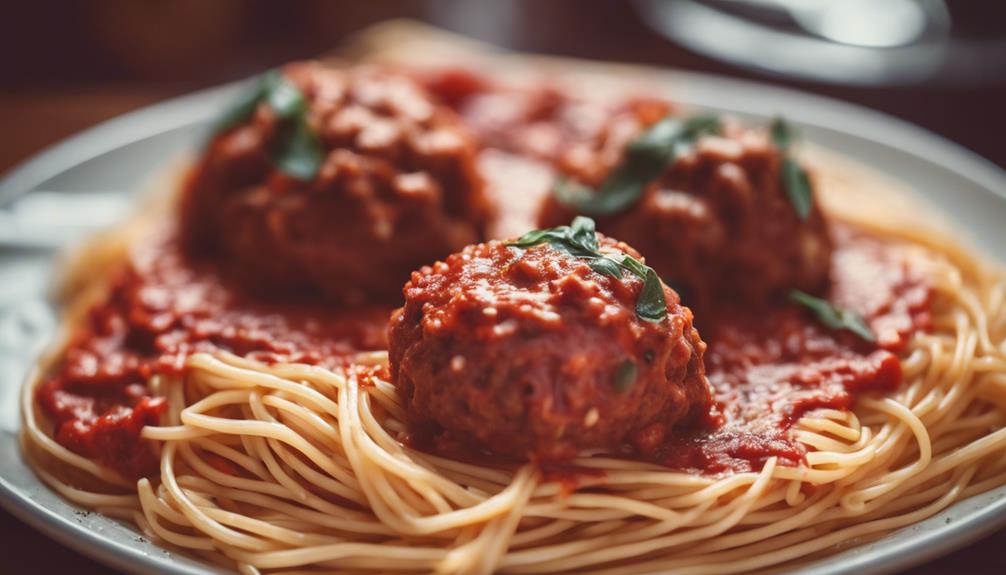If you’re craving traditional Italian dishes, pasta is the way to go! From spaghetti Bolognese to creamy risotto and delicious antipasti like bruschetta, prosciutto e melone, and caprese salad. Pizza lovers can indulge in classics like Margherita and Diavola, with unique toppings such as potato and rosemary. Don’t overlook seafood specialties, comforting soups, and hearty paninis. And for a sweet ending, Italian desserts like tiramisu and cannoli are a must-try. These are just a glimpse of the wide array of flavors that Italian cuisine has to offer; there is a whole world of culinary delights waiting for you to discover further!
Key Takeaways
- Italian common dishes include pasta varieties like spaghetti carbonara and lasagna.
- Risotto dishes like mushroom risotto are popular in Italian cuisine.
- Antipasti choices such as bruschetta and caprese salad are common starters.
- Pizza variations like Margherita and Diavola are widely enjoyed.
- Seafood specialties like shrimp scampi and calamari are common in Italian cooking.
Pasta Dishes
Pasta dishes are a fundamental aspect of Italian cuisine, enjoyed by people worldwide for their versatility and delicious flavors. Italian pasta, with its traditional durum wheat base, serves as a canvas for a myriad of delectable sauces. From the classic marinara to the creamy Alfredo, the options are endless when it comes to dressing up your favorite pasta shape.
Each region in Italy boasts its own signature pasta dish, reflecting the diversity of flavors and ingredients found throughout the country. Whether you prefer the hearty lasagne alla Bolognese from the north or the simple yet flavorful spaghetti alla carbonara from Rome, Italian pasta dishes never fail to tantalize the taste buds.
The beauty of Italian pasta lies not only in its taste but also in its ability to bring people together around the dining table.
Risotto Varieties
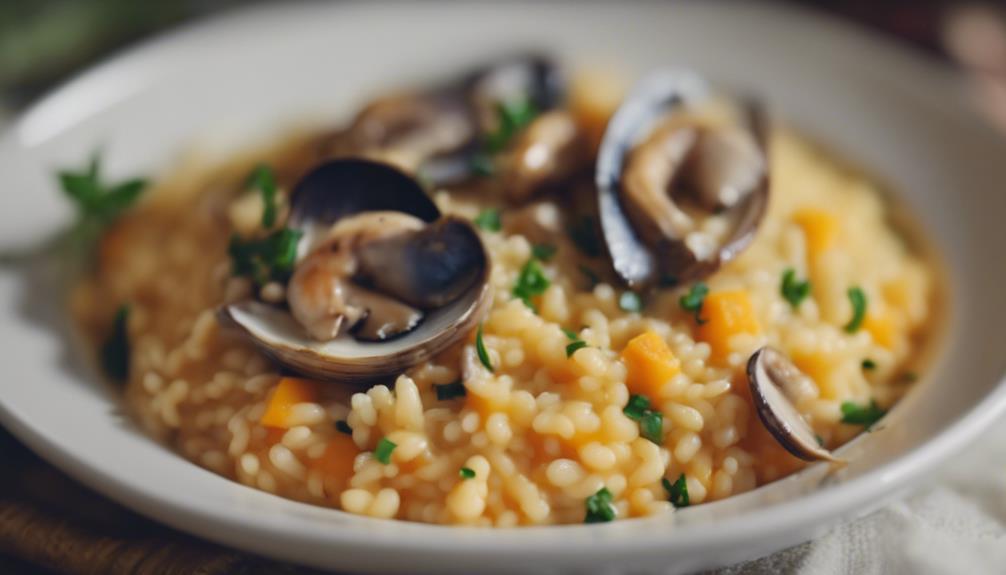
Risotto, a creamy Northern Italian dish, offers a delightful variety of flavors and ingredients to satisfy diverse palates. When it comes to risotto, the options are endless, allowing you to explore a range of delicious combinations.
Here are some popular variations to tantalize your taste buds:
- Cheese Delight: Indulge in the richness of cheesy risotto, where parmesan or gorgonzola cheese is melted into the creamy rice, creating a luxurious and comforting dish.
- Veggie Medley: For a lighter option, try a vegetable risotto packed with colorful veggies like mushrooms, asparagus, or peas, adding freshness and texture to each bite.
- Seafood Symphony: Immerse yourself in the depths of flavor with a seafood risotto featuring shrimp, clams, or squid, bringing a taste of the ocean to your plate.
Whether you prefer a decadent cheesy experience, a garden-fresh delight, or a seafood extravaganza, risotto has something for everyone to enjoy.
Antipasti Selections
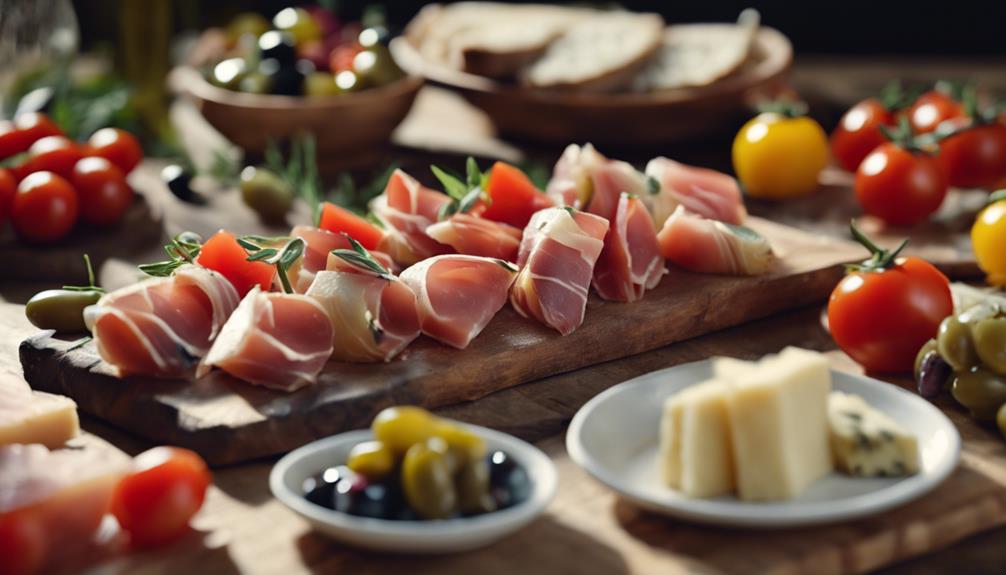
When it comes to antipasti selections, you're in for a treat!
Classic antipasti choices like bruschetta and cured meats will surely tantalize your taste buds.
Keep an eye out for regional variations and popular ingredients that make these appetizers truly special.
Classic Antipasti Choices
Common antipasti choices offer a delightful array of traditional Italian appetizers that set the stage for a flavorful dining experience. These appetizers, known for their burst of flavors and vibrant colors, are carefully crafted to tantalize your taste buds.
Here are three classic antipasti selections you must try:
- Bruschetta: This iconic dish consists of toasted bread topped with a savory mixture of tomatoes, garlic, basil, and olive oil. The crispiness of the bread combined with the invigorating sweetness of the toppings creates a perfect harmony of textures and tastes.
- Prosciutto e Melone: A simple yet elegant antipasto, this dish features thinly sliced prosciutto paired with sweet, juicy melon. The saltiness of the cured meat contrasts beautifully with the invigorating sweetness of the melon, offering a delightful flavor combination.
- Caprese Salad: A timeless favorite, the Caprese salad showcases the classic trio of ripe tomatoes, fresh mozzarella, and fragrant basil leaves drizzled with olive oil. Each bite brings together the richness of the cheese, the acidity of the tomatoes, and the herbal notes of the basil, creating a harmonious blend of flavors.
Regional Antipasti Variations
Exploring the diverse regional antipasti variations across Italy reveals a rich tapestry of unique ingredients and flavors that reflect the culinary traditions of each area. In Northern Italy, antipasti often feature delicacies such as prosciutto, melon, and grana padano cheese, showcasing a blend of savory and sweet flavors that tantalize the taste buds.
On the other hand, Southern Italy boasts antipasti like caponata, bruschetta, and marinated olives, offering a more robust and tangy culinary experience. Central Italy stands out with its own array of antipasti, including crostini, pecorino cheese, and an assortment of cured meats, providing a delightful mix of textures and tastes.
These regional variations in antipasti not only serve as appetizers to traditional Italian meals but also serve as a window into the diverse and vibrant culinary landscape of Italy. Each bite tells a story of local ingredients, time-honored recipes, and the passion Italians have for their food.
Popular Antipasti Ingredients
Discover a variety of popular antipasti ingredients that commonly grace Italian dining tables, including cured meats, cheeses, olives, and marinated vegetables.
- Cured Meats: Indulge in the rich flavors of prosciutto and salami, thinly sliced and expertly seasoned to tantalize your taste buds.
- Cheeses: Enjoy the nutty notes of Parmigiano Reggiano and the creamy goodness of fresh mozzarella, adding a delightful contrast to your antipasti platter.
- Olives and Marinated Vegetables: Delight in the briny goodness of marinated artichokes, roasted peppers, and a variety of olives that burst with Mediterranean flavors.
Antipasti aren't just appetizers; they're a culinary experience designed to stimulate your appetite and prepare your palate for the main course. These selections not only showcase regional flavors but also offer a mix of textures and tastes that embody the essence of Italian cuisine.
Pizza Variations

If you're a pizza lover, get ready to explore a world of flavors and toppings with Italian pizza variations.
Classic pizza types like Margherita pave the way for regional varieties that showcase unique topping combinations.
From the traditional pepperoni to creative mushroom and onion blends, each pizza tells a delicious story waiting for you to savor.
Classic Pizza Types
Sampling a variety of classic Italian pizzas reveals a diverse range of flavors and toppings that cater to different tastes and preferences. When exploring the world of Italian cuisine and its iconic pizzas, you'll encounter classics like the Margherita, a simple yet delicious combination of tomato sauce, fresh mozzarella, and fragrant basil.
Moving beyond the Margherita, you'll find other traditional options that offer a unique twist on the beloved dish:
- Quattro Stagioni: This pizza is a delightful representation of the four seasons, with each quadrant adorned with ingredients like artichokes, olives, prosciutto, and mushrooms.
- Diavola: For those craving a spicy kick, the Diavola pizza delivers with its fiery toppings of spicy salami or pepperoni that pack a flavorful punch.
- Capricciosa: A feast for the senses, the Capricciosa pizza combines ham, artichokes, mushrooms, and olives to create a symphony of flavors on a single crust.
Each of these classic pizza types showcases the ingenuity and creativity that characterize Italian culinary traditions.
Regional Pizza Variations
Exploring the diverse regions of Italy reveals a wide array of unique pizza variations that highlight the local flavors and culinary traditions. In Naples, the birthplace of pizza, you'll find the iconic pizza Margherita, topped with fresh tomatoes, mozzarella, basil, and a drizzle of olive oil. The Marinara pizza, also from Naples, features a simple yet delicious combination of tomato sauce, garlic, oregano, and olive oil on a thin crust.
Head over to Rome, and you'll encounter Roman pizza, known for its thin and crispy crust topped with a variety of fresh ingredients like arugula and prosciutto. If you find yourself in Sicily, be sure to try the Sicilian pizza, characterized by its thicker crust and flavorful toppings such as anchovies and Pecorino cheese.
In Liguria, along the picturesque Italian Riviera, indulge in the Ligurian pizza known as 'sardenaira,' a focaccia-like delight topped with a mouthwatering blend of tomatoes, onions, olives, and anchovies. Each regional pizza variation in Italy offers a unique culinary experience that reflects the rich gastronomic heritage of the area.
Unique Topping Combinations
Let's now shift our focus to the unique topping combinations found in various pizza variations across Italy. Italian pizzerias offer inventive options to tantalize your taste buds. From the classic prosciutto and arugula combo to the unexpected fig and gorgonzola mix, there's a pizza for every palate.
Here are some examples:
- Indulge in the savory flavors of a potato and rosemary pizza, a delightful twist on traditional Italian pizzas.
- Explore the sea with seafood lovers' dream pizzas boasting toppings like shrimp, clams, anchovies, or smoked salmon, bringing the taste of the Mediterranean to your plate.
- For a vegetarian delight, savor pizzas topped with roasted vegetables, fresh basil, sun-dried tomatoes, or creamy burrata cheese, offering a burst of flavors in every bite.
Italian pizzerias are known for pushing culinary boundaries, so don't hesitate to try these unconventional yet delicious pizza creations on your next visit!
Panini Options
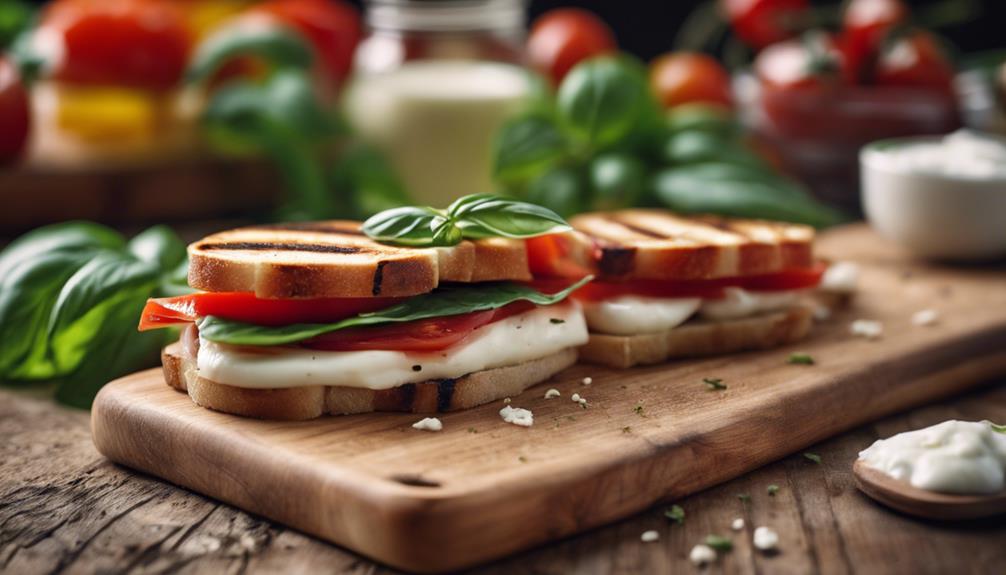
Discover a variety of delicious panini options that showcase the flavors of Italy. Panini, also known as Italian sandwiches, are typically made with ciabatta bread, adding a rustic texture to each bite. These sandwiches are often grilled or pressed, resulting in a warm and crispy exterior that complements the savory fillings inside.
Common panini fillings include a delightful combination of prosciutto, mozzarella, tomatoes, and fresh basil, creating a burst of Mediterranean flavors in every bite.
For those looking to explore beyond the traditional fillings, popular variations of panini include options with pesto for a burst of herbal goodness, grilled vegetables for a lighter and invigorating twist, or classic Italian meats for a heartier meal. These variations offer a diverse range of flavors that cater to different preferences while still maintaining the essence of Italian cuisine.
Whether enjoyed for lunch or as a quick snack, panini are a versatile and beloved staple in Italian culinary tradition.
Seafood Specialties
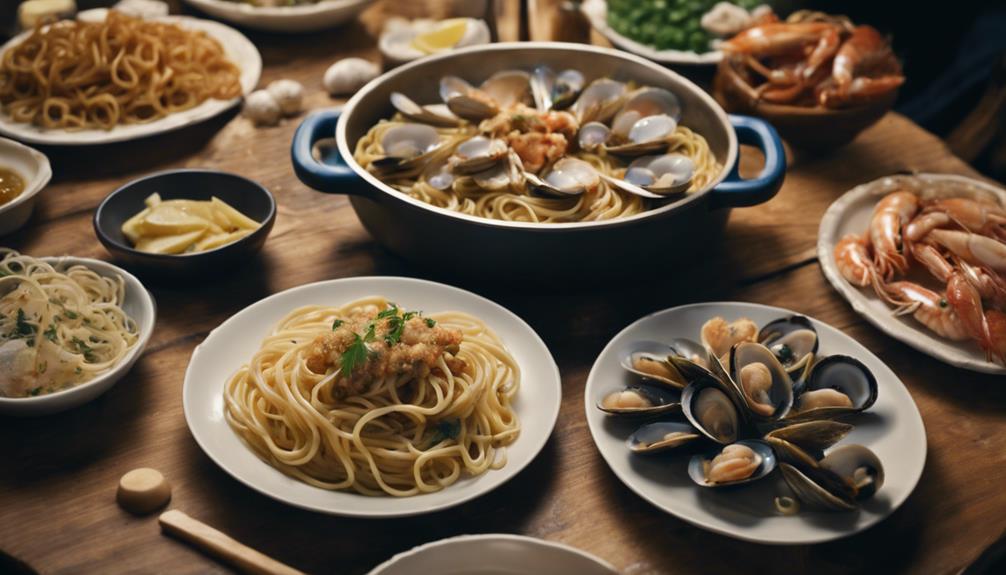
Love seafood? Italy has got you covered with its array of mouthwatering seafood specialties. Get ready to indulge in popular choices like shrimp, mussels, sardines, squid, and cod.
These traditional recipes are sure to transport your taste buds to the coastal regions of Italy!
Popular Seafood Choices
Italian cuisine presents a diverse array of seafood choices, including shrimp, mussels, sardines, squid, and cod. Seafood plays an essential role in Italian culinary traditions, adding a burst of freshness and flavor to many beloved dishes.
When exploring Italian seafood specialties, you'll encounter delicious options like:
- Seafood Risotto: A creamy and rich dish combining the flavors of the sea with the creaminess of Arborio rice, creating a comforting and indulgent meal.
- Pasta alle Vongole: This classic pasta dish features clams as the star ingredient, cooked with garlic, white wine, and parsley to create a simple yet incredibly flavorful dish.
- Feast of the Seven Fishes: A traditional Italian-American Christmas Eve celebration where a lavish spread of seven different seafood dishes is served, symbolizing different aspects of the holiday season.
Whether enjoying a seafood risotto in Venice or savoring Pasta alle Vongole in Rome, seafood remains a cornerstone of Italian cuisine, reflecting the country's deep-rooted connection to the sea.
Regional Seafood Variations
Regional seafood variations in Italy showcase a diverse array of flavors and culinary traditions across different parts of the country. From the northern regions like Liguria, known for their delicious seafood stews, to the southern coast of Sicily, where fresh swordfish and octopus reign supreme, each area offers unique seafood specialties that reflect its local culture and ingredients.
In Italian-American cuisine, a seafood feast is a grand affair featuring an assortment of shrimp, mussels, sardines, squid, and cod, celebrating the bounty of the sea.
Seafood plays an essential role in Italian gastronomy, especially during traditional feasts like Christmas Eve's 'Festa dei Sette Pesci,' where families enjoy a multi-course seafood extravaganza. The versatility of seafood in Italian cooking knows no bounds, with each region putting its own twist on classic dishes and creating new and exciting recipes.
Traditional Seafood Recipes
Frequently enjoyed across Italy, traditional seafood recipes feature a variety of flavorful ingredients and cooking techniques. When exploring Italian cuisine, the influence of seafood is undeniable, with dishes showcasing a mix of shrimp, mussels, sardines, squid, and cod as mainstays. Seafood takes center stage in many traditional Italian recipes, offering a taste of the Mediterranean with each bite.
One notable tradition in Italian culinary culture is the Feast of the Seven Fishes, a Christmas Eve celebration where families indulge in a lavish spread of seafood dishes.
Italian-American cuisine has also embraced the love for seafood, creating delectable dishes like seafood pasta and hearty cioppino stew.
Whether in classic dishes passed down through generations or modern interpretations in trendy restaurants, seafood remains a significant component of Italian gastronomy, pleasing palates across the globe.
Hearty Soups
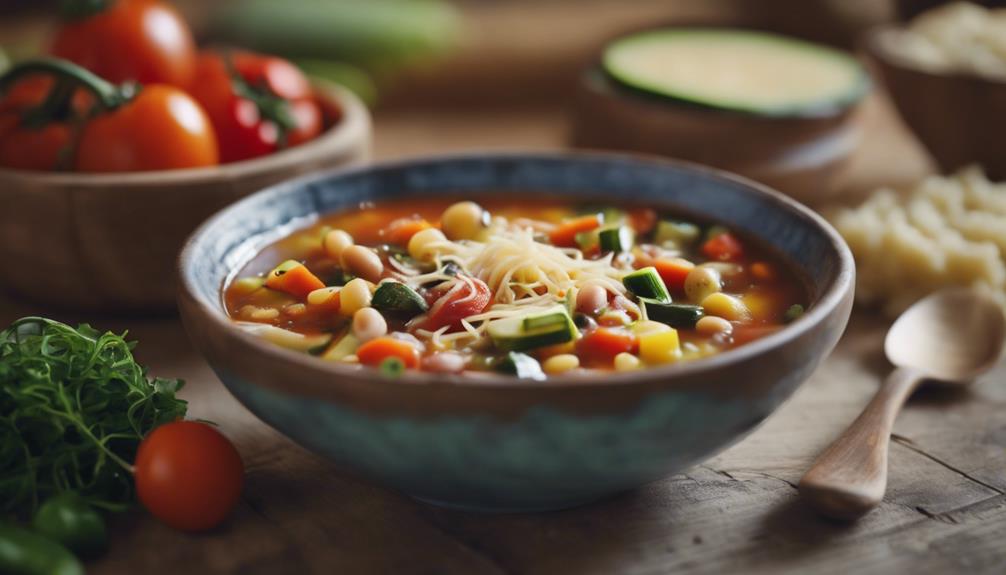
Explore a variety of hearty soups that showcase the rich flavors and diverse ingredients of Italian cuisine.
Minestrone, a traditional Italian soup, stands out with its medley of mixed vegetables, making it a symbol of Italian dinners.
For a taste of history, try Ribollita, a Tuscan rural soup dating back to the Middle Ages, featuring a hearty mix of bread, beans, and kale.
If you're in the mood for something light yet satisfying, Stracciatella alla Romana, an egg drop soup from Rome, offers a delicate blend of eggs, Parmesan, and nutmeg in a clear broth.
For seafood enthusiasts, Zuppa di Cozze is a popular choice in coastal regions, combining the flavors of mussels, tomatoes, garlic, and white wine in a delightful soup.
And if you want to experience a rustic delight, Acquacotta, a peasant soup from Tuscany, brings together vegetables, eggs, bread, and pecorino cheese in a hearty broth.
These Italian hearty soups are sure to warm your heart and soul with every comforting spoonful.
Italian Desserts

Indulge in a delightful array of iconic Italian desserts that showcase the sweet and decadent side of Italian cuisine.
- Tiramisù: Transport your taste buds to the Veneto region with this classic dessert. Layers of coffee-soaked Savoiardi biscuits, creamy mascarpone, and a dusting of cocoa powder create a heavenly treat that melts in your mouth.
- Pannacotta: Experience the velvety smoothness of pannacotta, a renowned Italian dessert. Its light texture, enhanced by golden sugar, and firm consistency achieved with gelatin make it a favorite among dessert enthusiasts.
- Gelato: Treat yourself to gelato, Italy's famed frozen dessert. Creamier and denser than regular ice cream, gelato comes in a myriad of flavors that cater to every palate, making it a cool and invigorating indulgence.
These desserts, whether it's the creamy Tiramisù, the silky Pannacotta, or the cool and invigorating Gelato, are a tribute to Italy's rich culinary heritage and a sweet ending to any meal.
Regional Specialties

Crafted with regional pride and unique flavors, Italian cuisine boasts a diverse array of regional specialties that showcase the country's culinary heritage. Each region in Italy offers its own traditional dishes, prepared with quality ingredients and bursting with distinct regional flavors. Let's explore some of these delightful specialties in the table below:
| Dish | Region | Description |
|---|---|---|
| Focaccia | Liguria | Originating in Liguria, this flatbread requires quality ingredients and skilled hands to create. |
| Arancini | Sicily | Sicilian rice balls filled with meat sauce, peas, and cheese, embodying the rich regional flavors. |
| Ribollita | Tuscany | A rustic Tuscan soup from the Middle Ages, symbolizing the heartiness of traditional Italian cuisine. |
| Bagna Cauda | Piedmont | Hailing from Piedmont, this dish features olive oil, anchovies, and garlic, representing regional specialties in Italy. |
These regional specialties not only offer a taste of authentic Italy but also highlight the diverse culinary traditions that make Italian cuisine so beloved worldwide.
Vegetarian Options

Italian cuisine offers a diverse selection of vegetarian options, ranging from classic pasta dishes to flavorful appetizers and pizzas. If you're looking for meat-free Italian dishes, you're in for a treat! Here are some delicious vegetarian options to explore:
- Eggplant Parmigiana: A scrumptious dish made with layers of fried eggplant, tomato sauce, and melted cheese, creating a delightful combination of flavors and textures.
- Risotto Primavera: This creamy risotto is packed with seasonal vegetables like peas, asparagus, and carrots, offering a burst of invigorating goodness in every bite.
- Caprese Salad: A simple yet elegant salad made with fresh tomatoes, mozzarella cheese, basil leaves, and a drizzle of olive oil, showcasing the essence of Italian cuisine in a light and invigorating way.
Whether you're a fan of pasta, salads, or appetizers, Italian cuisine has a wide array of vegetarian dishes to satisfy your cravings. So go ahead, indulge in these flavorful options and experience the vegetarian side of Italian gastronomy!
Frequently Asked Questions
What Are the 10 Most Popular Italian Dishes?
When thinking about the 10 most popular Italian dishes, you can explore a variety of flavors and textures. From hearty lasagna to delicate fettuccine, Italian cuisine offers a delicious experience for every palate.
What Is Italy's Most Common Dish?
When it comes to Italy's most common dish, pasta steals the show. Whether it's spaghetti alla carbonara or spaghetti Vongole, this versatile classic takes center stage in Italian cuisine, delighting taste buds everywhere.
What Are Classic Italian Dishes?
When it comes to classic Italian dishes, you can never go wrong with Pasta Carbonara, Margherita Pizza, or Tiramisù. These timeless favorites showcase the rich flavors and culinary heritage that Italy is renowned for.
What Are Italian Main Dishes?
You know Italian main dishes are a flavorful journey through pasta, meats, and seafood. Like a culinary artist, Italians craft dishes such as lasagna alla Bolognese and Pollo alla Cacciatora to delight your taste buds.
What Italian Dishes Can I Make Without Tomatoes?
If you’re looking to make Italian dishes without tomatoes, you can try making Aglio e Olio, a classic pasta dish with a garlic and olive oil sauce. Another option is Pesto Genovese, a flavorful sauce made from basil, pine nuts, and Parmesan cheese. Both are delicious alternatives to traditional Italian dishes with tomatoes.
Conclusion
To sum up, Italian cuisine is a rich tapestry of flavors, textures, and traditions that will tantalize your taste buds and leave you craving for more.
From mouth-watering pasta dishes to decadent desserts, Italy has something for every palate.
So, whether you're a foodie looking for a culinary adventure or simply seeking a satisfying meal, Italian cuisine is sure to satisfy your cravings in the most deliciously exaggerated way possible.
Buon appetito!



